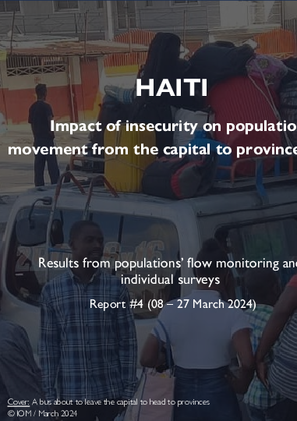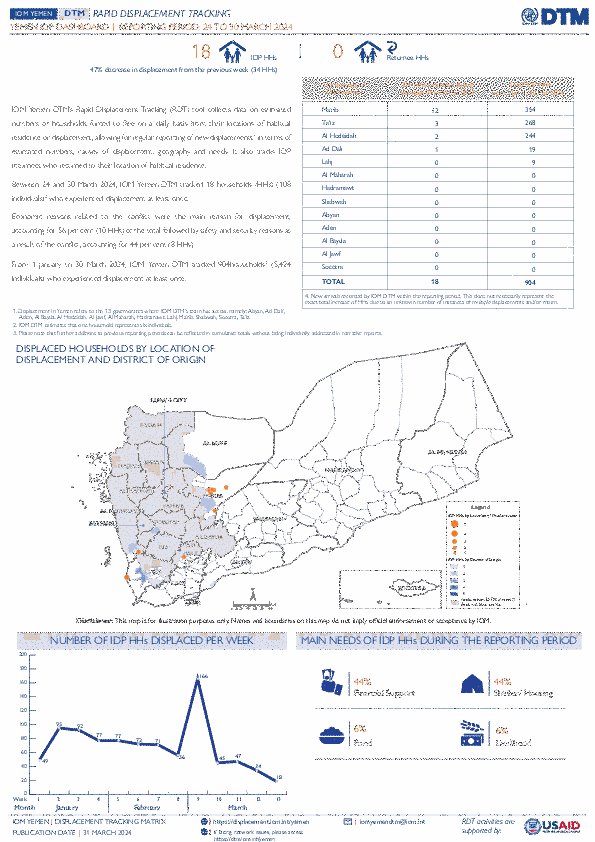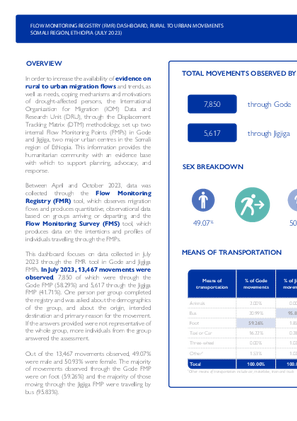-
Countries
-
Data and Analysis
-
Special Focus
-
Crisis Responses

Contact
DTMUkraine@iom.int
Language
English
Location
Ukraine
Period Covered
Feb 01 2024
Feb 29 2024
Activity
- Baseline Assessment
Базова територіальна оцінка зареєстрованих ВПО надає деталізовані дані щодо чисельності та географічного розподілу офіційно зареєстрованих внутрішньо переміщених осіб (ВПО). У звіті оцінено присутність зареєстрованих ВПО на рівні громад із відображенням на мапі зафіксованих змін порівняно з попереднім раундом.
Дані, зібрані для раунду 33 Базової територіальної оцінки, відображають актуальну статистику з місцевого адміністративного реєстру ВПО станом на 29 лютого 2024 року, згідно з якою в Україні налічується 3 413 472 зареєстровані ВПО. Дані щодо кількості зареєстрованих ВПО було зібрано для 1 098 громад (83% усіх оцінених громад на підконтрольних українському уряду територіях) у 108 районах 23 областей. Дані з розподілом за віком, статтю та статусом інвалідності було надано для приблизно 83% оцінених адміністративно-територіальних одиниць.

Contact
DTM Haiti, dtmhaiti@iom.int
Language
English
Location
Haiti
Period Covered
Mar 08 2024
Mar 27 2024
Activity
- Survey
- Flow Monitoring Survey
- Flow Monitoring
In recent weeks, armed attacks have intensified in the Metropolitan Area of Port-Au-Prince (MAPAP), the capital of Haiti. In addition to creating displacement within the MAPAP, attacks and generalized insecurity are pushing more and more people to leave the capital to find refuge in provinces, taking the risks of passing through gangs-controlled routes. In order to monitor these movements towards provinces and inform appropriate response strategies, DTM has launched data collection at several of the most used bus stations in the capital (see page 5 for more details on the methodology). Since the start of this activity, on 8 March, until 27 March, this activity allowed to observe the movements of 53,125 people leaving the MAPAP (see pages 3 and 4 for more details on the profile of these people ). The majority of them (61%) took means of transport heading towards the Grand Sud departments (Grande’Anse, South, Nippes and South-East). It should be noted that this region already hosts more than 116,000 people who had in vast majority, fled the MAPAP in recent months (see the report on displacement in the Grand Sud).
It should be emphasized that provinces do not have sufficient infrastructures and host communities do not have sufficient resources that can enable them to cope with these massive displacement flows coming from the capital.
Contact
DTM Yemen, iomyemendtm@iom.int
Location
Yemen
Activity
- Mobility Tracking
- Event Tracking
Period Covered
Mar 24 2024 -Mar 30 2024
From 1 January to 30 March 2024, IOM Yemen DTM tracked 904 households (HH) (5,424 Individuals) who experienced displacement at least once.
Between 24 and 30 March 2024, IOM Yemen DTM tracked 18 households (108 individuals) displaced at least once. The majority of people moved into/within the following governorates and districts:
- Ma’rib (12 HHs) – Ma’rib City (6 HHs), Ma’rib (4 HHs), Harib (2 HHs) districts. Most displacements in the governorate originated from Ma’rib and Dhamar.
- Ta’iz (3 HHs) – Al Makha (3 HHs) district. All displacements in the governorate were internal.
- Al Hodeidah (2 HHs) – Hays (2 HHs) district. All displacements in the governorate were internal.
The majority of people moved from the following governorates and districts:
- Ta’iz (4 HHs) – Mawza (3 HHs), Ash Shamayatayn (1 HH) districts.
- Al Hodeidah (3 HHs) – Al Jarrahi (2 HHs), Al Marawiah (1 HH) districts.
- Ibb (2 HHs) – Ar Radmah (1 HH), Al Qafr (1 HH) districts.
Population Groups
Survey Methodology
Unit of Analysis Or Observation
Type of Survey or Assessment
Keywords
Geographical Scope
Administrative boundaries with available data
The current dataset covers the following administrative boundaries

Contact
DTM Yemen, iomyemendtm@iom.int
Language
English
Location
Yemen
Period Covered
Mar 24 2024
Mar 30 2024
Activity
- Mobility Tracking
- Event Tracking
IOM Yemen DTM’s Rapid Displacement Tracking (RDT) tool collects data on estimated numbers of households forced to flee on a daily basis from their locations of origin or displacement, allowing for regular reporting of new displacements in terms of estimated numbers, geography, and needs. It also tracks returnees who returned to their location of origin.
From 1 January to 30 March 2024, IOM Yemen DTM tracked 904 households (HH) (5,424 Individuals) who experienced displacement at least once.
Between 24 and 30 March 2024, IOM Yemen DTM tracked 18 households (108 individuals) displaced at least once. The majority of people moved into/within the following governorates and districts:
- Ma’rib (12 HHs) – Ma’rib City (6 HHs), Ma’rib (4 HHs), Harib (2 HHs) districts. Most displacements in the governorate originated from Ma’rib and Dhamar.
- Ta’iz (3 HHs) – Al Makha (3 HHs) district. All displacements in the governorate were internal.
- Al Hodeidah (2 HHs) – Hays (2 HHs) district. All displacements in the governorate were internal.
The majority of people moved from the following governorates and districts:
- Ta’iz (4 HHs) – Mawza (3 HHs), Ash Shamayatayn (1 HH) districts.
- Al Hodeidah (3 HHs) – Al Jarrahi (2 HHs), Al Marawiah (1 HH) districts.
- Ibb (2 HHs) – Ar Radmah (1 HH), Al Qafr (1 HH) districts.
IOM identified 7 households displaced in the previous reporting period, which covered 17 - 23 March 2024, in the governorates of Ta’iz (4 HHs), and Ma’rib (3 HHs). These figures have been added to the cumulative displacement total recorded since the beginning of the year.

Contact
DTM Ethiopia, DTMEthiopia@iom.int
Language
English
Location
Ethiopia
Period Covered
Jul 01 2023
Jul 31 2023
Activity
- Flow Monitoring
In order to increase the availability of evidence on rural to urban migration flows and trends, as well as needs, coping mechanisms and motivations of drought-affected persons, the International Organization for Migration (IOM) Data and Research Unit (DRU), through the Displacement Tracking Matrix (DTM) methodology, set up and piloted two internal Flow Monitoring Points (FMPs) in Gode and Jigjiga, two major urban centres in the Somali region of Ethiopia. The pilot ran from June 2023 through August 2023.
This dashboard focuses on data collected in July 2023 through the FMR tool in Gode and Jigjiga FMPs. In July 2023, 13,467 movements were observed, 7,850 of which were through the Gode FMP (58.29%) and 5,617 through the Jigjiga FMP (41.71%).

Contact
dtmremapsupport@iom.int mtmtajikistan@iom.int
Language
English
Location
Tajikistan
Period Covered
Sep 13 2023
Nov 11 2023
Activity
- Survey
- Baseline Assessment
The surveys were conducted with return migrant workers using IOM’s Mobility Tracking Matrix (MTM) system in Tajikistan. The survey locations were selected based on the results of IOM’s Baseline Mobility Assessment on returning migrant workers. The report includes findings on socio-economic profile, migration experience, employment and remittances. The survey sample was calculated based on a Baseline Assessment on the presence of returning migrant workers in the selected locations. The interviews were conducted using mobile devices and the KoBo software. All interviews were anonymous, and IOM’s Data Protection Principles were observed throughout the entire data cycle. Data collectors approached potential respondents using the snowball method to obtain their informed consent.

Contact
DTM Sudan, DTMSudan@iom.int
Language
English
Location
Sudan
Period Covered
Feb 22 2024
Mar 21 2024
Activity
- Mobility Tracking
- Baseline Assessment
This report reflects data corresponding to Monthly Displacement Overview 07 dataset, valid as of 21 March 2024. The dataset is available here.
Overview
IOM DTM Sudan presents its seventh Monthly Displacement Overview. This publication provides an account of Sudan’s displacement context since 15 April 2023 – outlining population mobility and displacement, as well as the present and evolving needs of IDPs across Sudan. It provides further contextual analysis for all 18 states for the period between 22 February and 21 March 2024.
Rationale
Recognizing the need for more detailed insights into the IDP situation, including the priority needs, access to services, movement intentions, and demographic breakdowns of the affected population, DTM Sudan has undertaken a comprehensive review of our data collection tool. In collaboration with a wide range of internal and external stakeholders, we have developed a new tool to better inform humanitarian response operations, aligning with the DTM global methodology. Leveraging our extensive network of approximately 367 field-based enumerators and a robust system of over 3,362 key informants across the country, DTM gathered data on IDPs across 7,037 locations, in 181 of Sudan’s 189 localities, across all of Sudan’s 18 states, during March 2024.
Key Findings
- DTM Sudan estimates that 6,552,118 individuals (1,308,617 households) have been recently internally displaced.
- IOM DTM also reports that an estimated 2,019,027 mixed cross-border movements have been made into neighbouring countries.
- Since 15 April 2023, 46 per cent of the IDP caseload sought refuge in the Darfur and Kordofan regions, whereas 53 per cent were observed across the Northern, Eastern, and Central states.
- The majority of the IDP caseload (66%) were seeking shelter with the host community.
- While food remains the highest priority need, health and non-food items are also growing concerns.

Contact
DTM Chad, dtmtchad@iom.int
Language
French
Location
Chad
Period Covered
Mar 26 2023
May 08 2023
Activity
- Survey
Depuis 2015, le Tchad fait l’objet d’attaques perpétrées par des groupes armés non-étatiques présents dans le bassin du Lac Tchad engendrant des déplacements massifs de populations, aussi bien internes que transfrontaliers. Le round 20 d'évaluation des sites et des villages mené entre le 26 mars et le 08 mai 2023 dans 250 lieux de déplacement dans la province du lac Tchad a fait état d'une population déplacée totale de 259 768 personnes, dont 215 928 personnes déplacées internes (PDI) (82 % de la population déplacée), 22 893 retournés de l'étranger (11%) et 20 947 anciens déplacés internes (7%). Parmi les localités qui accueillent des PDI, 80 pour cent ont indiqué que la principale cause de déplacement était les attaques armées, tandis que 16 pour cent l'ont été à titre préventif par crainte d'une attaque. Pour les localités qui accueillent des retournés de l’étranger, la principale raison évoquée dans 96 pour cent des localités pour leur retour est l'attaque armée. Quant aux localités qui accueillent les retournés anciennes PDI, les deux principales raisons du retour sont la recherche de moyens de subsistance et la recherche de meilleures conditions sécuritaires, évoquées respectivement par 68 pour cent et 32 pour cent des localités. Un grand nombre de PDI se trouvent dans des lieux de déplacement depuis 2015.
Dans ce contexte de déplacements prolongés et nouveaux, il est crucial de disposer d'outils de collecte de données pouvant guider les stratégies de transition humanitaire et de développement. C'est dans cette optique que la Matrice de suivi des déplacements (Displacement Tracking Matrix (DTM), en anglais) met en place plusieurs outils dans la province du Lac Tchad, dont l'indice de solution et de mobilité. L'objectif de cet indice est d'évaluer la perception de la stabilité des populations déplacées dans leurs zones d'accueil et de mettre en évidence les facteurs influençant cette perception. Le but ultime est de permettre une programmation ciblée dans les localités qui tiennent compte des facteurs qui contribuent le plus à la perception de la stabilité des populations déplacées et, ainsi, permettre des interventions cohérentes qui lient les approches humanitaires, transitoires et de développement en fonction de la situation de la localité.
Ce rapport présente les résultats du round 3 de l'indice de solution et de mobilité dans la Province du Lac Tchad. Les données utilisées pour calculer l'indice de solution et de mobilité ont été collectées entre mars et mai 2023.

Contact
DTM South Sudan, SouthSudanDTM@iom.int
Language
English
Location
South Sudan
Period Covered
Jul 01 2023
Aug 31 2023
Activity
- Survey
The overall goal of the 2023 humanitarian Inter-Sector Needs Assessment (ISNA) was to collect and analyze data on the needs and vulnerabilities of households, displacement and migration history, shelter and non-food items (SNFI), water, sanitation and hygiene (WASH), health, education, protection, and social cohesion.
The ISNA was intended to fill the information gaps for the 2024 Humanitarian Needs Overview and update the two-year Humanitarian Response Plan (2023-2024). The data collection conducted between July and August 2023, addresses these gaps, while fully respecting accountability to the affected populations and minimizing assessment fatigue.
A total of 12,394 individual household members (hereinafter referred to as 'the survey respondents' or 'respondents') across South Sudan's 10 states and Abyei Administrative Area (here in referred to as 'Abyei') participated in the assessment. Among the total, 62.5 per cent were host community members, 19.7 per cent were returnees, and 17.8 per cent were IDPs. The reported average household size is 5.6 persons per household. The survey targeted heads of households, but in their absence, an individual household member answered on their behalf.
15 per cent of respondents reported having at least one member with a disability, 4 per cent of whom face moderate or severe challenges. This aligns with the WHO's global average. Additionally, chronic illness affects a significant 22 per cent of households, underscoring the need for accessible healthcare within the rural areas of South Sudan
A concerning 48.1 per cent of households have at least one member with a health issue. More critically, 67.9 per cent reported difficulties in accessing healthcare when needed. The primary issues contributing to this are the significant distance to health facilities (50.8%) and lengthy waiting times for services (37.8%). More primary health care and mobile/outreach facilities are needed to address the accessibility and efficiency of healthcare services, ensuring that households in need of health services can promptly receive the care they require.
79.5 per cent indicated that not every individual in their household possesses a valid identification document posing a challenge for the upcoming elections. With 50.7 per cent of the population requiring access to civil documentation, urgent attention is needed to facilitate the documentation process. 39.7 per cent of households reported they attempted to access civil documentation but faced obstacles which is alarming, this underscores the need for interventions to ensure a smooth and accessible documentation process for all citizens. Addressing this is crucial for facilitating democratic participation and ensuring equal civic rights for the entire population.
Enrollment rates among school-aged children were significantly lower in Lakes (57%), Jonglei (53.2%), Northern bahr El Ghazal (52.3%), Unity (52.3%) and Warrap (49.6%) compared to other states in the current school year. Addressing the high rates of school non-enrollment in these states is crucial to improving educational outcomes in these regions.
Nearly 60 per cent of the population needs protective services, yet almost half (46.4%) face roadblocks in accessing them. Movement restrictions due to insecurity affect 24.6 per cent of households, highlighting the urgency to enhance security measures. Additionally, 15.5 per cent express concern about early marriage for girls, emphasizing the need to implement programs to fight early marriage and promote girls’ education. Equally alarming is the 10.4 per cent reporting unlawful detention as a primary protection concern for boys. Immediate attention and targeted programs are essential to address these pressing protection issues.

Contact
DTM DRC, iomdrcdtm@iom.int
Language
English
Location
Democratic Republic of the Congo
Period Covered
Mar 07 2024
Mar 16 2024
Activity
- Mobility Tracking
- Baseline Assessment
Following the escalation of hostilities between the armed group Mouvement du 23 Mars (M23) and the Congolese Armed Forces (FARDC) and their allies at the end of January 2024, a significant displacement crisis has developed in the eastern region of the Democratic Republic of Congo (DRC), particularly in the North Kivu province. Many individuals and families have been uprooted from their communities, seeking safety and shelter in various areas due to deteriorating security conditions. The intensification of the conflict has forced households to abandon their residences, leading to massive displacements from their places of origin to host communities, established sites, collective centers, and newly created sites. In response to these population movements, especially towards existing or newly established sites, the Displacement Tracking Matrix (DTM) has conducted registrations to keep the data up to date, collect informationon new sites,regularly informstakeholders about the evolutionof movements, and provide data for potential humanitarian assistance.
